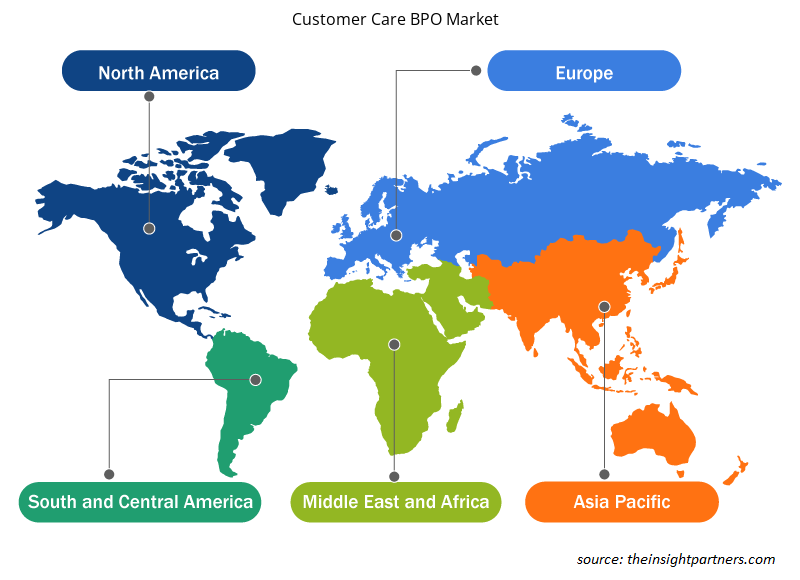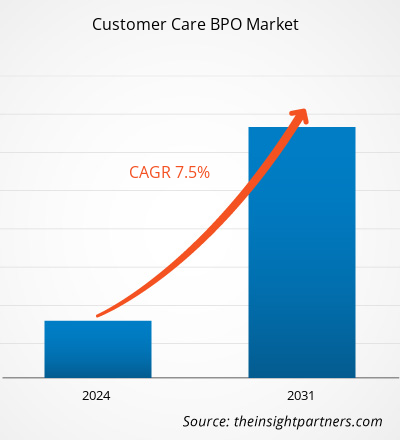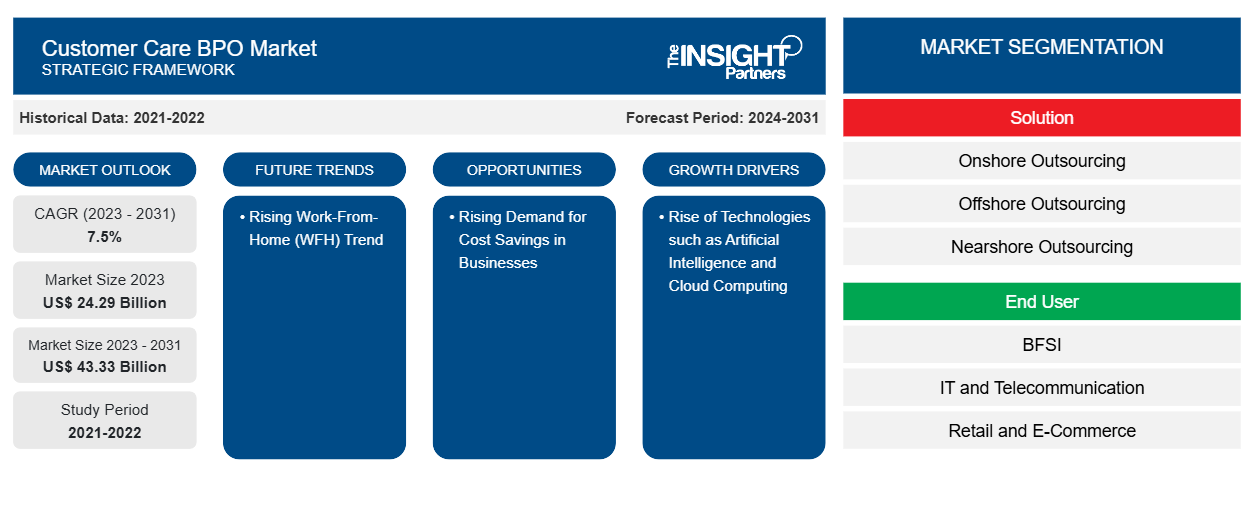Si prevede che la dimensione del mercato BPO dell'assistenza clienti raggiungerà i 43,33 miliardi di dollari entro il 2031, rispetto ai 24,29 miliardi di dollari del 2023. Si prevede che il mercato registrerà un CAGR del 7,5% nel periodo 2023-2031. È probabile che la crescente implementazione dell'IA rimanga una tendenza chiave nel mercato.
Analisi di mercato BPO per l'assistenza clienti
L'outsourcing dell'assistenza clienti comporta l'utilizzo di servizi di terze parti per gestire l'interazione con i clienti nelle fasi di pre-acquisto, acquisto e post-acquisto. Questi servizi vengono forniti tramite vari canali, tra cui sito Web, e-mail o messaggistica, telefono, chat online in tempo reale, social media e messaggi di testo o messaggi. L'utilizzo di queste soluzioni multicanale aiuta le aziende di outsourcing a fornire servizi in modo efficiente. La crescita del mercato BPO dell'assistenza clienti è facilitata dalla crescente tendenza al lavoro da casa (WFH) in settori come IT e telecomunicazioni e BFSI. Questa tendenza offre opportunità agli operatori di mercato di innovare e sviluppare nuovi modelli di fornitura.
Panoramica del mercato BPO dell'assistenza clienti
I servizi di Business Process Outsourcing (BPO) riguardano principalmente la gestione dell'outsourcing dei processi aziendali per soddisfare le esigenze di un cliente. Questi servizi sono responsabili di specifiche operazioni aziendali. Le funzioni aziendali più comunemente esternalizzate includono operazioni di back-office come contabilità e finanza, risorse umane e servizi di assistenza clienti. Gli outsourcer di elaborazione aziendale del servizio clienti (BPO) hanno il potenziale per incrementare significativamente le attività offrendo supporto al servizio clienti e conoscenze specialistiche che aiutano le aziende ad attrarre e mantenere i clienti.
Personalizza questo report in base alle tue esigenze
Riceverai la personalizzazione gratuita di qualsiasi report, comprese parti di questo report, o analisi a livello nazionale, pacchetto dati Excel, oltre a usufruire di grandi offerte e sconti per start-up e università
-
Scopri le principali tendenze di mercato in questo rapporto.Questo campione GRATUITO includerà analisi di dati che spaziano dalle tendenze di mercato alle stime e alle previsioni.
Driver e opportunità del mercato BPO per l'assistenza clienti
L'ascesa di tecnologie come l'intelligenza artificiale e il cloud computing favoriscono il mercato
La crescente integrazione dell'intelligenza artificiale (IA) nei servizi di Business Process Outsourcing (BPO) per l'assistenza clienti è stata guidata dall'evoluzione tecnologica, dalla trasformazione digitale e dalla pandemia di COVID-19. Questa integrazione ha consentito ai fornitori di servizi di migliorare le comunicazioni in tempo reale con i clienti, rivoluzionando il modo in cui i marchi si collegano al loro pubblico. L'IA, insieme al cloud computing, ha colmato il divario tra la grande quantità di dati generati e la capacità di utilizzare questi dati per l'interazione con i clienti in tempo reale. Questa integrazione ha consentito alle aziende BPO di offrire supporto 24 ore su 24, 7 giorni su 7, risolvere problemi semplici e personalizzare i propri servizi. Nelle attività di vendita, l'IA ha facilitato la personalizzazione e il ridimensionamento del processo di vendita.
Il riconoscimento vocale basato sull'intelligenza artificiale, gli assistenti virtuali e le risposte vocali interattive hanno ridotto significativamente i tempi di attesa dei clienti prima di raggiungere un responsabile dell'assistenza clienti. Inoltre, il ruolo del routing omnicanale basato sull'intelligenza artificiale ha consentito un passaggio fluido tra più canali, come chat e chiamate vocali, con i responsabili sempre pronti a rispondere alle richieste o ai reclami dei clienti. Gli Smart BPO integrati con l'intelligenza artificiale hanno aiutato le aziende a ottimizzare e automatizzare i propri servizi, con conseguenti processi aziendali più convenienti, rispettosi dell'ambiente ed efficienti. Pertanto, si stima che l'emergere di tecnologie come l'intelligenza artificiale e il cloud computing guiderà la crescita del mercato BPO dell'assistenza clienti nei prossimi anni.
Crescente domanda di risparmio sui costi nelle aziende
L'outsourcing del servizio clienti ha il potenziale per produrre significative riduzioni dei costi. Questo perché le aziende di Business Process Outsourcing (BPO) del servizio clienti possiedono già infrastrutture consolidate ed efficienze operative, eliminando la necessità di ulteriore spazio ufficio, attrezzature, costi di formazione e altre spese correlate necessarie per l'inserimento di agenti di supporto in un ufficio domestico. Tuttavia, la partnership con un BPO del servizio clienti può aiutare a eliminare questi costi, poiché hanno già l'infrastruttura necessaria e le efficienze operative in atto. Ciò consente loro di offrire un supporto di alta qualità a un costo ridotto rispetto al mantenimento di un team interno, con la preoccupazione principale dell'inserimento del BPO. Inoltre, le organizzazioni possono spesso ottenere maggiori risparmi sui costi collaborando con un BPO offshore che utilizza agenti internazionali. Ciò può essere notevolmente vantaggioso per le organizzazioni che cercano un supporto clienti multilingue.
Analisi della segmentazione del rapporto di mercato BPO di assistenza clienti
I segmenti chiave che hanno contribuito alla derivazione dell'analisi di mercato del Customer Care BPO sono l'implementazione, le dimensioni dell'organizzazione e l'applicazione.
- In base alla soluzione, il mercato è segmentato in outsourcing onshore, outsourcing offshore e outsourcing nearshore. Il segmento dell'outsourcing onshore ha detenuto una quota di mercato significativa nel 2023.
- In termini di utente finale, il mercato è suddiviso in BFSI, IT e telecomunicazioni, vendita al dettaglio ed e-commerce , produzione, sanità e farmaceutica, trasporti e logistica, media e comunicazione, automotive e altri. Il segmento IT e telecomunicazioni ha detenuto una quota sostanziale del mercato nel 2023.BFSI, IT and telecommunication, retail and
Analisi della quota di mercato del Customer Care BPO per area geograficaBPO Market Share Analysis by Geography
L'ambito geografico del rapporto sul mercato BPO dell'assistenza clienti è suddiviso principalmente in cinque regioni: Nord America, Asia Pacifico, Europa, Medio Oriente e Africa, Sud e Centro America.BPO market report is mainly divided into five regions: North America, Asia Pacific, Europe, Middle East & Africa, and South & Central America.
Il mercato BPO dell'assistenza clienti in Nord America è diviso in Canada, Stati Uniti e Messico. Noi deteniamo la quota maggiore di questo mercato in Nord America. La presenza di numerose grandi aziende negli Stati Uniti, come Microsoft Corporation, Apple Inc., Proctor & Gamble e General Motors, ha portato a una maggiore domanda di rappresentanti del servizio clienti per soddisfare le varie esigenze dei clienti. Secondo l'US Bureau of Labor Statistics, nel 2021 negli Stati Uniti erano impiegate più di 2.890.000 persone come rappresentanti del servizio clienti. Gli Stati Uniti sono noti per il loro progresso tecnologico, l'adozione precoce di tecnologie avanzate e la presenza di varie aziende tecnologiche, tra cui sia piccole e medie imprese (PMI) che grandi imprese. Ciò ha contribuito all'evoluzione esponenziale del paese.BPO market in North America is divided into Canada, the US, and Mexico. We hold the largest share of this market in North America. The presence of numerous large companies in the US, such as Microsoft Corporation, Apple Inc., Proctor & Gamble, and General Motors, has led to an increased demand for customer service representatives to meet various customer needs. According to the US Bureau of Labor Statistics, more than 2,890,000 people were employed as customer service representatives in the US in 2021. The US is known for its technological advancement, early adoption of advanced technologies, and the presence of various tech firms, including both small and medium enterprises (SMEs) and large enterprises. This has contributed to the country's exponential evolution.
Approfondimenti regionali sul mercato BPO dell'assistenza clientiBPO Market Regional Insights
Le tendenze regionali e i fattori che influenzano il mercato Customer Care BPO durante il periodo di previsione sono stati ampiamente spiegati dagli analisti di Insight Partners. Questa sezione discute anche i segmenti e la geografia del mercato Customer Care BPO in Nord America, Europa, Asia Pacifico, Medio Oriente e Africa e America centrale e meridionale.BPO Market throughout the forecast period have been thoroughly explained by the analysts at Insight Partners. This section also discusses Customer Care BPO Market segments and geography across North America, Europe, Asia Pacific, Middle East and Africa, and South and Central America.

- Ottieni i dati specifici regionali per il mercato BPO dell'assistenza clienti
Ambito del rapporto di mercato BPO di assistenza clienti
| Attributo del report | Dettagli |
|---|---|
| Dimensioni del mercato nel 2023 | 24,29 miliardi di dollari USA |
| Dimensioni del mercato entro il 2031 | 43,33 miliardi di dollari USA |
| CAGR globale (2023-2031) | 7,5% |
| Dati storici | 2021-2022 |
| Periodo di previsione | 2024-2031 |
| Segmenti coperti |
Per soluzione
|
| Regioni e Paesi coperti |
America del Nord
|
| Leader di mercato e profili aziendali chiave |
|
Densità dei player del mercato BPO del servizio clienti: comprendere il suo impatto sulle dinamiche aziendali
Il mercato del Customer Care BPO Market sta crescendo rapidamente, spinto dalla crescente domanda degli utenti finali dovuta a fattori quali l'evoluzione delle preferenze dei consumatori, i progressi tecnologici e una maggiore consapevolezza dei vantaggi del prodotto. Con l'aumento della domanda, le aziende stanno ampliando le loro offerte, innovando per soddisfare le esigenze dei consumatori e capitalizzando sulle tendenze emergenti, il che alimenta ulteriormente la crescita del mercato.BPO Market market is growing rapidly, driven by increasing end-user demand due to factors such as evolving consumer preferences, technological advancements, and greater awareness of the product's benefits. As demand rises, businesses are expanding their offerings, innovating to meet consumer needs, and capitalizing on emerging trends, which further fuels market growth.
La densità degli operatori di mercato si riferisce alla distribuzione di aziende o società che operano in un particolare mercato o settore. Indica quanti concorrenti (operatori di mercato) sono presenti in un dato spazio di mercato in relazione alle sue dimensioni o al valore di mercato totale.
Le principali aziende che operano nel mercato Customer Care BPO sono:BPO Market are:
- Alorica Inc Inc
- Telus International CDA Inc
- Contatta semplicemente International
- Comdata SpA
- Concentrix Corp Corp
- Fondatore Operating Corp
Disclaimer : le aziende elencate sopra non sono classificate secondo un ordine particolare.

- Ottieni una panoramica dei principali attori del mercato BPO del servizio clienti
Notizie di mercato e sviluppi recenti del Customer Care BPO
Il mercato BPO dell'assistenza clienti viene valutato raccogliendo dati qualitativi e quantitativi dopo la ricerca primaria e secondaria, che include importanti pubblicazioni aziendali, dati associativi e database. Di seguito sono elencati alcuni degli sviluppi nel mercato BPO dell'assistenza clienti:
- Solera, leader mondiale nella gestione dello stile di vita dei veicoli, ha presentato oggi la sua offerta di servizi BPO, XpertCX Solutions Suite. Progettata per ridefinire l'esperienza del cliente, questa suite innovativa fornisce un approccio olistico ai servizi BPO, offrendo supporto end-to-end in tutto il settore automobilistico. Combinando perfettamente tecnologia all'avanguardia con esperienza consolidata, XpertCX Solutions Suite mira a semplificare le operazioni, amplificare l'efficienza e aumentare la soddisfazione del cliente in tutto il settore. Inoltre, mentre Solera continua a dare priorità alla crescita di XpertCX Solutions Suite e del suo ramo BPO, l'azienda inaugurerà un nuovo spazio ufficio il 27 marzo, dedicato ad accogliere oltre 400 dipendenti del servizio clienti a Jacksonville, Florida.
(Fonte: Solera, Comunicato stampa, marzo 2024)
Copertura e risultati del rapporto di mercato BPO per l'assistenza clienti
Il rapporto "Customer Care BPO Market Size and Forecast (2021–2031)" fornisce un'analisi dettagliata del mercato che copre le seguenti aree:
- Dimensioni e previsioni del mercato BPO dell'assistenza clienti a livello globale, regionale e nazionale per tutti i segmenti di mercato chiave coperti dall'ambito
- Tendenze del mercato BPO dell'assistenza clienti e dinamiche di mercato come driver, vincoli e opportunità chiave
- Analisi dettagliata delle cinque forze PEST/Porter e SWOT
- Analisi di mercato BPO dell'assistenza clienti che copre le principali tendenze di mercato, il quadro globale e regionale, i principali attori, le normative e i recenti sviluppi del mercato
- Analisi del panorama industriale e della concorrenza che copre la concentrazione del mercato, l'analisi della mappa di calore, i principali attori e gli sviluppi recenti per il mercato BPO dell'assistenza clienti
- Profili aziendali dettagliati
- Analisi storica (2 anni), anno base, previsione (7 anni) con CAGR
- Analisi PEST e SWOT
- Valore/volume delle dimensioni del mercato - Globale, Regionale, Nazionale
- Industria e panorama competitivo
- Set di dati Excel
Report recenti
Testimonianze
Motivo dell'acquisto
- Processo decisionale informato
- Comprensione delle dinamiche di mercato
- Analisi competitiva
- Analisi dei clienti
- Previsioni di mercato
- Mitigazione del rischio
- Pianificazione strategica
- Giustificazione degli investimenti
- Identificazione dei mercati emergenti
- Miglioramento delle strategie di marketing
- Aumento dell'efficienza operativa
- Allineamento alle tendenze normative























 Ottieni un campione gratuito per - Mercato BPO dell'assistenza clienti
Ottieni un campione gratuito per - Mercato BPO dell'assistenza clienti